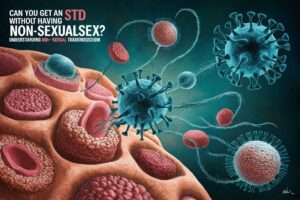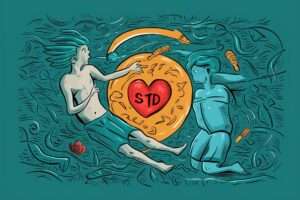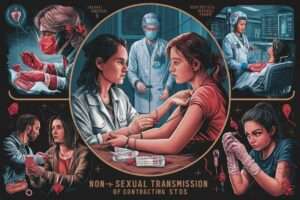Can You Get an STD Without Having Sex? Understanding Non-Sexual Transmission
While sexual activity is the primary mode of transmission for most sexually transmitted diseases (STDs), it’s a common misconception that sexual contact is the only way to contract these infections.
In this comprehensive guide, we’ll explore the various ways STDs can be transmitted without sexual intercourse, debunk myths, and provide essential information to help you protect your health.

Table of Contents
ToggleUnderstanding STDs and Their Transmission
Before diving into non-sexual transmission, it’s crucial to understand what STDs are and how they typically spread. Sexually transmitted diseases, also known as sexually transmitted infections (STIs), are infections that can be passed from one person to another through sexual contact. These include diseases like chlamydia, gonorrhea, syphilis, HIV, herpes, and human papillomavirus (HPV).
While sexual contact remains the primary route of transmission for most STDs, there are several other ways these infections can spread without engaging in sexual activity.

Non-Sexual Transmission of STDs
1. Mother-to-Child Transmission
One of the most common forms of non-sexual STD transmission is from mother to child during pregnancy, childbirth, or breastfeeding. This type of transmission is also known as vertical transmission.
– During Pregnancy: Some STDs, such as HIV, syphilis, and hepatitis B, can cross the placenta and infect the fetus.
– During Childbirth: As the baby passes through the birth canal, it may be exposed to infections like chlamydia, gonorrhea, or herpes.
– Through Breastfeeding: HIV can be transmitted through breast milk.
According to the Centers for Disease Control and Prevention (CDC), approximately 1 in 4 pregnant women with HIV who don’t receive treatment during pregnancy can transmit the virus to their babies [1].
2. Blood-to-Blood Contact
STDs that are bloodborne, such as HIV and hepatitis B and C, can be transmitted through blood-to-blood contact. This can occur in various ways:
– Sharing needles or other drug paraphernalia
– Accidental needlestick injuries in healthcare settings
– Blood transfusions (though this is rare in countries with advanced screening procedures)
– Sharing personal care items like razors or toothbrushes (for hepatitis B and C)
The World Health Organization (WHO) reports that sharing contaminated needles and syringes accounts for about 1.7% of new HIV infections globally [2].
3. Skin-to-Skin Contact
Some STDs can be transmitted through skin-to-skin contact, even without sexual intercourse. Examples include:
– Herpes simplex virus (HSV): Can be transmitted through kissing or any direct contact with an active sore.
– Human papillomavirus (HPV): Can spread through intimate skin-to-skin contact.
– Molluscum contagiosum: While not always considered an STD, it can be transmitted through skin contact.
4. Bodily Fluids
Certain STDs can be spread through contact with infected bodily fluids, such as:
– Saliva: While rare, it’s possible to contract herpes through kissing.
– Blood: As mentioned earlier, bloodborne infections like HIV and hepatitis can be transmitted through blood contact.
– Urine and feces: Some infections, like cytomegalovirus (CMV), can be spread through contact with contaminated bodily waste.

5. Shared Personal Items
While less common, some STDs can potentially be transmitted through shared personal items:
– Towels or washcloths: Trichomoniasis may survive briefly on damp fabrics.
– Sex toys: If not properly cleaned between uses or shared between partners.
– Razors or toothbrushes: Can potentially transmit bloodborne infections like hepatitis B or C.
Debunking Common Myths
It’s important to address some common misconceptions about non-sexual STD transmission:
Myth 1: You can get an STD from a toilet seat.
Fact: STDs cannot survive long on surfaces, and the skin on your buttocks acts as a barrier. The risk of contracting an STD from a toilet seat is virtually non-existent.
Myth 2: Swimming pools can spread STDs.
Fact: Chlorine and other pool chemicals kill most germs, including STDs. It’s extremely unlikely to contract an STD from a swimming pool.
Myth 3: You can get an STD from hugging or casual touch.
Fact: Most STDs require direct contact with infected bodily fluids or affected skin areas. Casual touch like hugging or handshakes do not transmit STDs.

Protecting Yourself from Non-Sexual Transmission
While the risk of non-sexual transmission is generally lower than sexual transmission, it’s still important to take precautions:
1. Practice good hygiene: Wash your hands regularly and avoid sharing personal items like razors or toothbrushes.
2. Use protection during sexual activity: Consistent and correct use of condoms can significantly reduce the risk of STD transmission.
3. Get vaccinated: Vaccines are available for some STDs, including hepatitis B and HPV.
4. Get tested regularly: Regular STD testing is crucial, especially if you’re sexually active or have multiple partners.
5. Seek medical care: If you suspect you’ve been exposed to an STD, seek medical attention promptly.
6. Education and awareness: Stay informed about STDs and their transmission methods to make informed decisions about your health.
When to Seek Medical Attention?
If you experience any of the following symptoms, it’s important to consult a healthcare provider:
– Unusual discharge from the genitals
– Pain or burning during urination
– Sores, bumps, or rashes in the genital area
– Pelvic pain
– Unexplained fever or fatigue
Remember, many STDs can be asymptomatic, so regular testing is crucial even if you don’t have symptoms.
Conclusion
While sexual contact remains the primary mode of STD transmission, it’s important to understand that these infections can spread through other means as well. By staying informed, practicing good hygiene, and taking appropriate precautions, you can significantly reduce your risk of contracting or spreading STDs, whether through sexual or non-sexual transmission.
Remember, knowledge is power when it comes to sexual health. Don’t hesitate to speak with a healthcare provider if you have concerns or questions about STDs and their transmission.
Reference to External Sources:
[1] https://www.cdc.gov/hiv/group/gender/pregnantwomen/index.html
[2] https://www.who.int/news-room/fact-sheets/detail/hiv-aids


